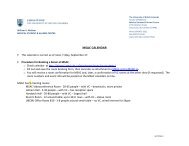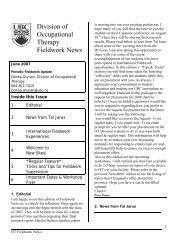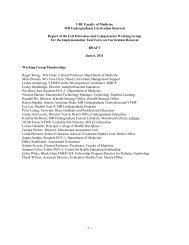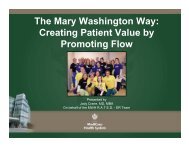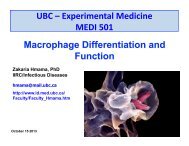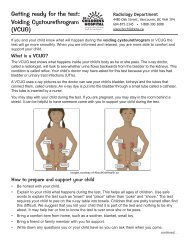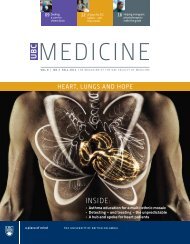MEDICINE
download a copy - University of British Columbia Faculty of Medicine
download a copy - University of British Columbia Faculty of Medicine
- No tags were found...
You also want an ePaper? Increase the reach of your titles
YUMPU automatically turns print PDFs into web optimized ePapers that Google loves.
UBC <strong>MEDICINE</strong> 9<br />
A girl, in a specially equipped van, has her brain’s electrical activity<br />
monitored as part of the Gene Expression Collaborative for Kids<br />
Only (GECKO) Project, a UBC study co-led by Michael Kobor.<br />
Photo credit: Human Early Learning Partnership<br />
in determining how cells behave. Whether methylation occurs,<br />
and where on the DNA it takes place, is now believed to be heavily<br />
influenced by environmental conditions.<br />
In essence, Dr. Kobor and his collaborators are seeking the<br />
biological nexus, or nexuses, between nature (genes) and nurture<br />
(upbringing): whether certain adverse experiences, such as abuse,<br />
poverty or loneliness, leave lasting marks on the biology of the<br />
brain that lead to such maladies as depression, aggression or<br />
addiction.<br />
“There is a huge amount of very diverse but very high quality data<br />
about these children’s lives, and how they behave,” Dr. Kobor says.<br />
“We can use cutting-edge technology to measure the methylation<br />
state of almost all of the 20,000 to 25,000 human genes. With that,<br />
we should be able to establish that what is true in rats might be<br />
transferable to humans.”<br />
Dr. Kobor, however, is no expert in early childhood development.<br />
Until recently, he was studying the epigenetics of yeast.<br />
But upon hearing Dr. Kobor describe his work at a Grand Rounds<br />
presentation at the Child & Family Research Institute, Ron Barr,<br />
a Professor of Pediatrics, saw the potential for applying it to<br />
children. Dr. Barr, who had studied the correlation between caregiving<br />
and infant development, proposed that they go back to his<br />
research subjects to get DNA samples.<br />
That is just one of about 45 cohorts that Dr. Kobor and his<br />
collaborators will use over the next three years. Other cohorts<br />
include: Quebecois children raised by mothers who experienced<br />
depression and even physical abuse; a similar collection of<br />
Singaporean mothers and children; U.S. children whose mothers<br />
were tutored by nurses in proper parenting techniques; a group<br />
of Wisconsin adolescents who have been followed, along<br />
with their parents, from birth; and a group of children whose<br />
cognitive, emotional and physical traits (including their brains’<br />
electrical activity) were assessed by UBC’s Human Early Learning<br />
Partnership, often in the back of a specially-equipped van.<br />
In all of these cases, the participants’ DNA will be analyzed by<br />
Dr. Kobor’s CMMT lab. The methylation of each donor’s DNA will<br />
be matched with data about the donor’s life, and the search for<br />
commonalities will begin.<br />
“When I was a graduate student, we were measuring two or three<br />
of these methylation marks in a few samples in a year,” says<br />
Dr. Kobor, the Director of Social Epigenetics at the Human Early<br />
Learning Partnership (HELP). “Now we’re measuring half a million<br />
marks in 192 people in five days. There has been a huge explosion<br />
in our ability to do this. And because we do this better than many<br />
people in the world, we’ve become a hub for social epigenetics.”<br />
Michael Kobor.<br />
Photo credit:<br />
Angelique Crowther<br />
“Whatever we do<br />
around our children<br />
might leave an imprint<br />
on their genome,<br />
or more accurately,<br />
their epigenome.”<br />
That UBC has become such a hub, and that Dr. Kobor finds<br />
himself at the centre of it, is due largely to the late Clyde<br />
Hertzman, a Professor in the School of Population and Public<br />
Health and Director of HELP who died suddenly in February<br />
2013. Dr. Hertzman, who dedicated his career to demonstrating<br />
how early life experiences affect a child’s brain and social<br />
development, was quick to grasp the implications of Dr. Meaney’s<br />
rat experiments, and along with Dr. Barr, saw how Dr. Kobor’s<br />
expertise could take it further.<br />
“Clyde was a master of getting people together and getting them<br />
excited about projects,” Dr. Kobor says. “All of this started with<br />
a $100,000 grant that HELP gave us six years ago.”<br />
If Dr. Kobor and his collaborators find that childhood experience<br />
does leave biochemical marks on the DNA of brain cells, and<br />
perhaps other organs, it might help identify which children are<br />
most at-risk, and thus which children should be the highest<br />
priority for prevention or intervention programs. But it also carries<br />
implications for individual behaviour.<br />
“We should perhaps be aware that whatever we do around<br />
our children might leave an imprint on their genome, or more<br />
accurately, their epigenome,” Dr. Kobor says. “It reminds us to be<br />
the best parents we can.”



